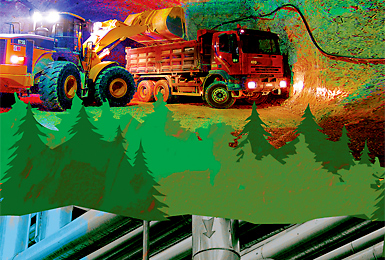Western Canada: Leading Out of the Recession
Driven by natural resources and a knowledge-based work force, the resurgence of Manitoba, Saskatchewan, Alberta, and British Columbia is good news for the Canadian economy.
September 2010

"The West is on fire," says Adam Waterous, Scotia Capital's Calgary-based head of global investment banking. "It's fantastic news for the country. These are big, big projects that are going to get developed. And there's no question that the West is going to lead the country out of the recession."
Western Canada's fortitude lies in the diversity and expanse of its natural resource sectors, which are picking up steam after a tough 2009. Vast reserves of oil, gas, timber, diamonds, metals, hydroelectric power, and rich agricultural lands have created one of the most reliable resource-based economies in the world. The West has wisely expanded beyond this base to diversify into high-growth, knowledge-based sectors, building globally-recognized clusters in aerospace, alternative energy, biomedical, biotechnology, information and communications technology, and advanced manufacturing.
The sharp decrease in demand for resources around the world last year hit Western Canada's commodity-based provinces hard. The areas took four of the last five spots in real GDP growth in the country in 2009. But now, with demand for natural resources rising, along with new incentives to improve the energy markets, the economy is on the move. Oil prices have more than doubled from recession-level lows, and investment activity has started to pick up.
Renewed Asian demand for natural resources - especially minerals, metals, industrial raw materials, and lumber - has triggered the turnaround. Companies are also negotiating favorable, longer-term fixed-price contracts due to higher commodity prices. And Western Canada, especially British Columbia, "will reap the benefits of reinvigorated Asia Pacific growth," says Warren Lovely, senior economist for the Canadian Imperial Bank of Commerce (CIBC).
"The theme of the West outperforming the rest should persist into 2011 as global commodity demands remain firm, while a strong Canadian dollar tempers growth in central Canada, and capital investment activity begins to wane in Atlantic Canada," says Michael Gregory, senior economist for BMO Capital Markets.
Supporting Each Other
British Columbia, Alberta, Saskatchewan, and Manitoba have a long history of collaboration among themselves and with other countries to market the region as innovative and progressive for business. The Pacific NorthWest Economic Region (PNWER), a public-private partnership chartered by Alaska, Idaho, Montana, Oregon, Washington, Alberta, British Columbia, Saskatchewan, Yukon, and the Northwest Territories, encourages global economic competitiveness. Last year PNWER facilitated energy and transportation infrastructure projects, bio-response planning, and border crossing policies between the two countries.
To further enhance their global competitiveness, British Columbia, Saskatchewan, and Alberta launched the New West Partnership in 2010, Canada's largest inter-provincial, barrier-free trade and investment market. These provinces will collaborate on trade and investment missions to international markets and develop cutting-edge R&D initiatives, especially in clean technology, natural resources, and agriculture. It completed its first major mission, a joint trip to China and Japan, in May.
"Asian companies and investors like what we have to offer and want to do business with us," says British Columbia Premier Gordon Campbell. "As Canada's Pacific Gateway, British Columbia has much to gain from increasing its trading relationship with Asia, including Japan. By joining forces with Alberta and Saskatchewan, we can be even more effective attracting investment and opportunity."
Having great ideas is one thing; securing the capital to turn those ideas into reality is another. All four western provinces benefit from Western Economic Diversification Canada's (WEDC) Western Economic Partnership Agreements (WEPAs), multi-year federal funding commitments that improve economic activity, especially for innovative new technologies and services. The organization has committed $200 million until 2013. For every dollar invested by the federal government in WEPAs, $1.65 was leveraged from other sources, studies show. Since it began in 1996, WEDC has invested almost $600 million in industries including forestry and paper, alternative fuel, agriculture, composites manufacturing, nanotechnology, and biomedicine - all high-growth sectors for the West.
Project Announcements
FUJIFILM Diosynth Biotechnologies Expands Holly Springs, North Carolina, Operations
04/15/2024
Two Rivers Lumber Plans Coosa County, Alabama, Sawmill Operations
04/15/2024
Protomet Corporation Plans Rockwood, Tennessee, Operations
04/15/2024
Corky’s Food Manufacturing Expands Memphis, Tennessee, Operations
04/14/2024
Spectrum Advanced Manufacturing Technologies Expands Colorado Springs, Colorado, Operations
04/11/2024
Norplas Industries Establishes Rossford, Ohio, Production Operations
04/11/2024
Most Read
-
2023's Leading Metro Locations: Hotspots of Economic Growth
Q4 2023
-
2023 Top States for Doing Business Meet the Needs of Site Selectors
Q3 2023
-
Manufacturing Momentum Is Building
Q1 2024
-
38th Annual Corporate Survey: Are Unrealized Predictions of an Economic Slump Leading Small to Mid-Size Companies to Put Off Expansion Plans?
Q1 2024
-
20th Annual Consultants Survey: Clients Prioritize Access to Skilled Labor, Responsive State & Local Government
Q1 2024
-
Public-Private Partnerships Incentivize Industrial Development
Q1 2024
-
Making Hybrid More Human in 2024
Q1 2024



